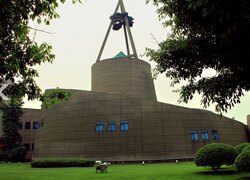Sanxingdui Museum in Guanghan
 Sanxingdui museum, which is 40 km from Chengdu, is one of the most important historical sites in China because of its size, enriched content, and rarity of its excavated objects. The site is protected by National Key Cultural Relics unit since 1988. The museum is located in between the Yazi and Mamu Rivers and covers 12 square kilometers.
Sanxingdui museum, which is 40 km from Chengdu, is one of the most important historical sites in China because of its size, enriched content, and rarity of its excavated objects. The site is protected by National Key Cultural Relics unit since 1988. The museum is located in between the Yazi and Mamu Rivers and covers 12 square kilometers.
History
Some of the first objects that were put in the museum were found in 1929 by a farmer while digging a well. In the process, the farmer unearthed a large stash containing jade relics. Then, in 1986, several workers discovered sacrificial pits where they found pottery artifacts, bronze, gold, and jade which were completely unknown in the history of Chinese art.
The artifacts that were unearthed in 1986, have convinced researchers that Sanxingdui was Shu Kingdom’s capital back more than 3,000 years ago. Among the artifacts collected, the bronze proved to be the most precious due to their scientific, historical, and artistic value.
Museum’s major sections
In order to organize the whole place and the relics, the museum is divided into 4 major sections where more than 1,000 pieces of artifacts from the two sacrificial pits can be found. These include gold plates, jade articles, bronze ware, pottery, and ivory.
Section 1
The first section consists of 5 individual units. The first one serves as an introduction of the ancient Shu. The next four sections feature relics that feature technical achievements, skill, and extraordinary imagination of the Shu people through the techniques they’ve used in their handicrafts.
Section 2
This section is dedicated on one topic alone; divinity and human. Imitative real scene can be found that shows the mental world of Shu people.
Section 3
Visitors can find the 10 groups of cultural relics that symbolize the ever-lasting spirit of the Shu people.
Section 4
This section focuses on the impact of the museum and its relics to other countries. It tells the story when the excavation sites were discovered.
What to expect
Visitors can expect to find extraordinary artifacts there. These include spooky masks with bulbous nose and bulging eyes, tree with serpentine branches, shamanic figure with over exaggerated face, etc. They are part of Sichuan mystery that shook up Chinese history.
Useful Information
Add: Riverside of the Xiyazi River, Guanghan City, Deyang City
Admission: CNY 80Opening Hours: 8:30am-6pm
English guide fee: CNY 120
Getting there: Take bus 6 from Guangham City



